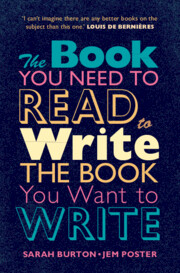Book contents
- Reviews
- The Book You Need to Read to Write the Book You Want to Write
- The Book You Need to Read to Write the Book You Want to Write
- Copyright page
- Dedication
- Contents
- Preface
- Acknowledgements
- – 1 – Getting started
- – 2 – Memory and imagination
- – 3 – Character
- – 4 – Plot and structure I
- – 5 – Plot and structure II
- – 6 – Form and length
- – 7 – Dialogue
- – 8 – Narrative viewpoint and narrative voice
- – 9 – Beginnings and endings; tension and pace
- – 10 – Description
- – 11 – Research
- – 12 – Drawing it all together
- – 13 – Publication and the writing life
- Notes
- Select bibliography
- Index
– 3 – - Character
Published online by Cambridge University Press: 17 February 2022
- Reviews
- The Book You Need to Read to Write the Book You Want to Write
- The Book You Need to Read to Write the Book You Want to Write
- Copyright page
- Dedication
- Contents
- Preface
- Acknowledgements
- – 1 – Getting started
- – 2 – Memory and imagination
- – 3 – Character
- – 4 – Plot and structure I
- – 5 – Plot and structure II
- – 6 – Form and length
- – 7 – Dialogue
- – 8 – Narrative viewpoint and narrative voice
- – 9 – Beginnings and endings; tension and pace
- – 10 – Description
- – 11 – Research
- – 12 – Drawing it all together
- – 13 – Publication and the writing life
- Notes
- Select bibliography
- Index
Summary
Character and plot are inextricably intertwined: characters make plot. Methods of introducing character. Investigating the respective usefulness of ‘showing’ and ‘telling’. A well-drawn character accumulates in the reader’s mind rather than springing fully fledged from the first page. How ‘showing’ character aids the creative process. Individualising characters. A character wants something; motive drives action and action drives plot. The relationship between narrative voice and character. The problems of too many characters. Managing minor characters. Believable characters are not always consistent; characters are fluid and flawed. Over-planning characters can be dangerous, limiting their potential and removing their ability to evolve.
‘For our characters to approach the texture of ""real"" people the writer, as well as the reader, needs to be curious about them, and that is impossible if we have removed their capacity to surprise us.’
Keywords
- Type
- Chapter
- Information
- The Book You Need to Read to Write the Book You Want to WriteA Handbook for Fiction Writers, pp. 17 - 34Publisher: Cambridge University PressPrint publication year: 2022

